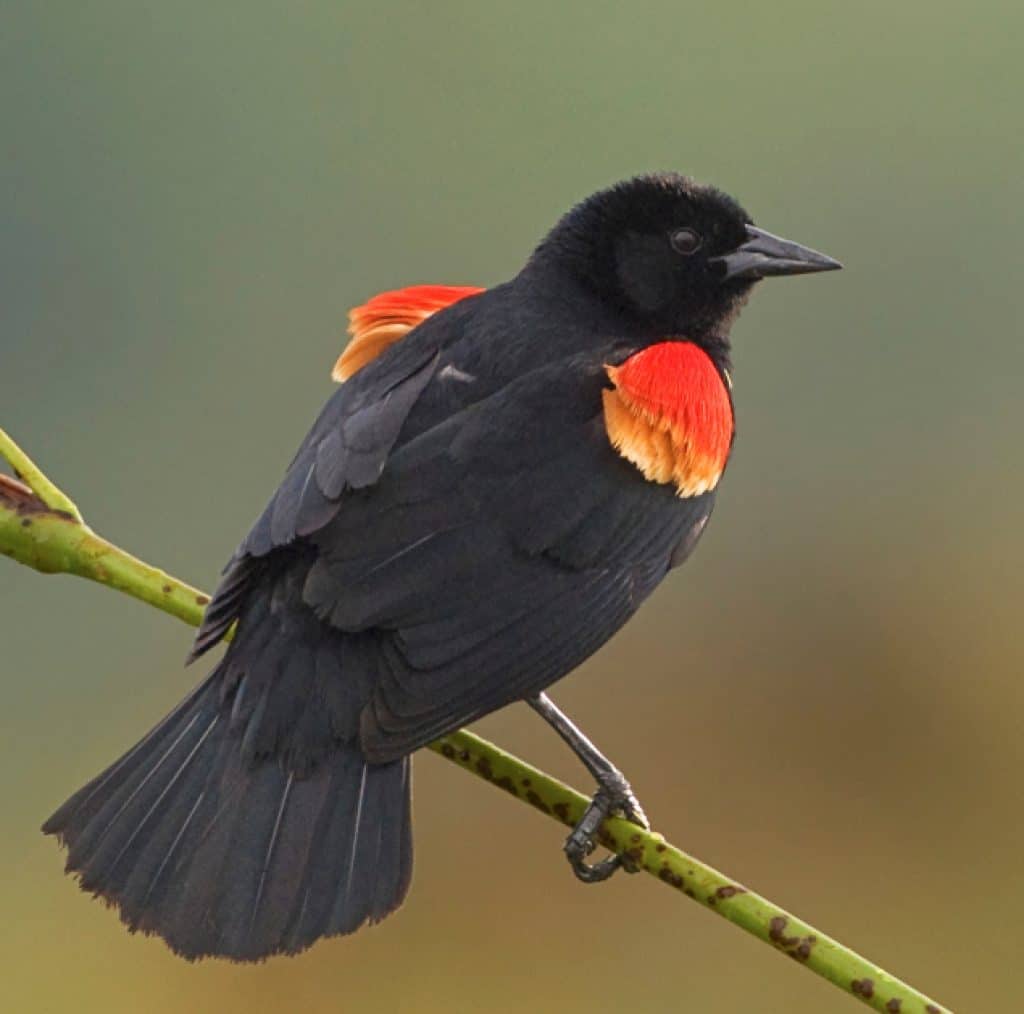
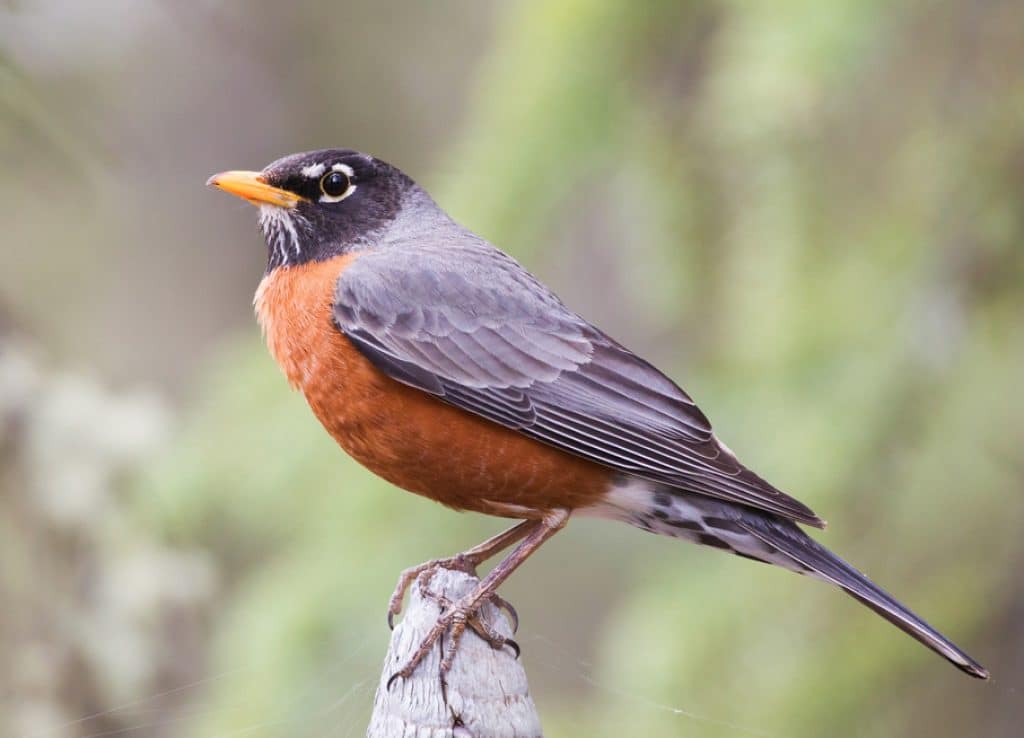
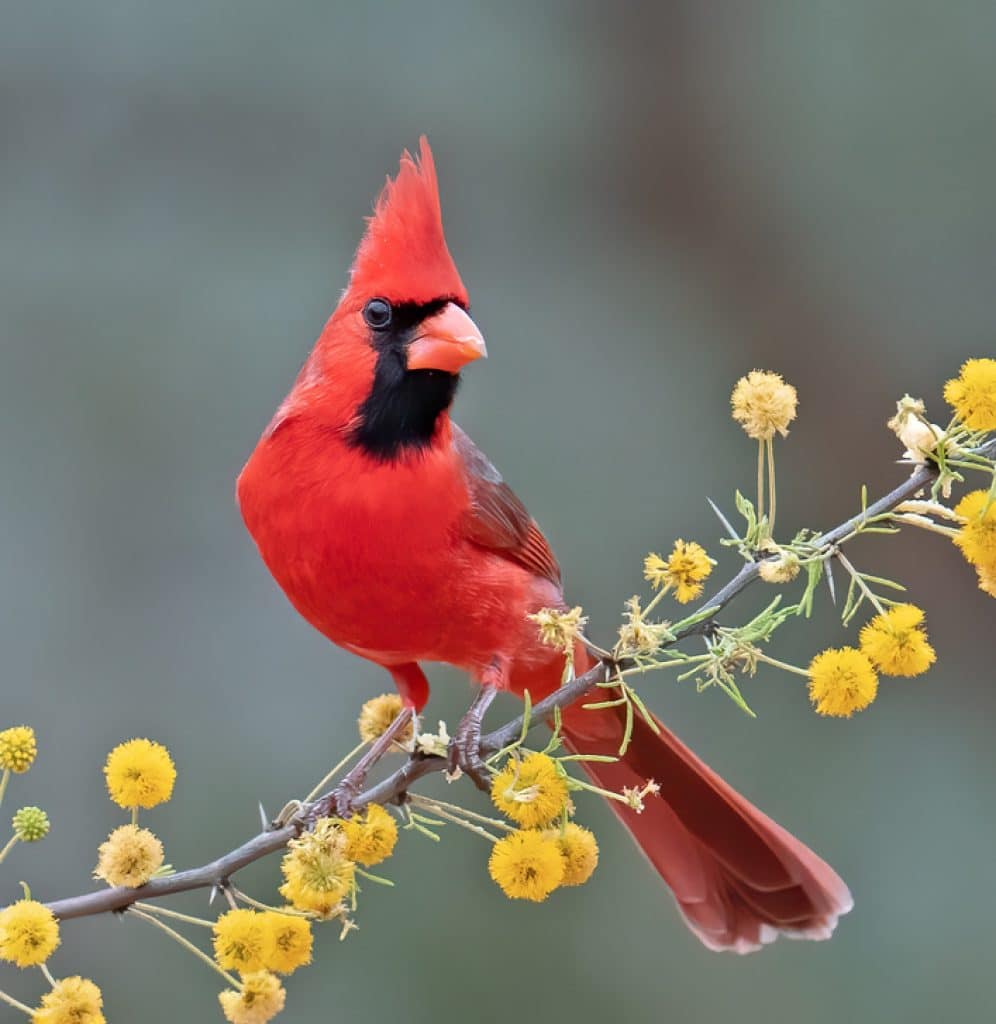
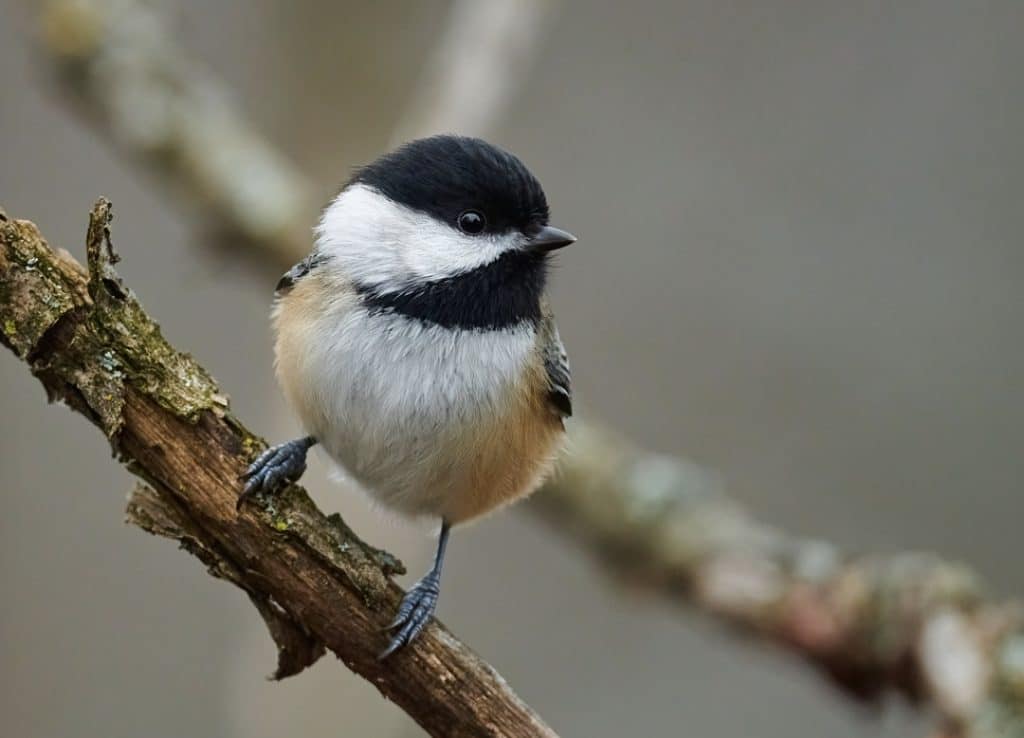
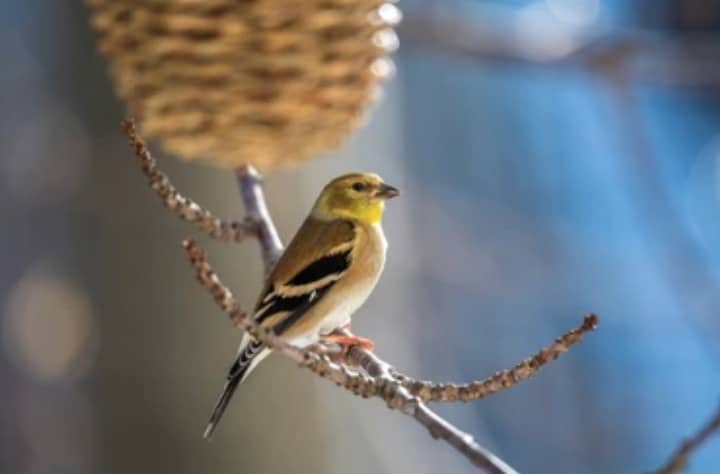
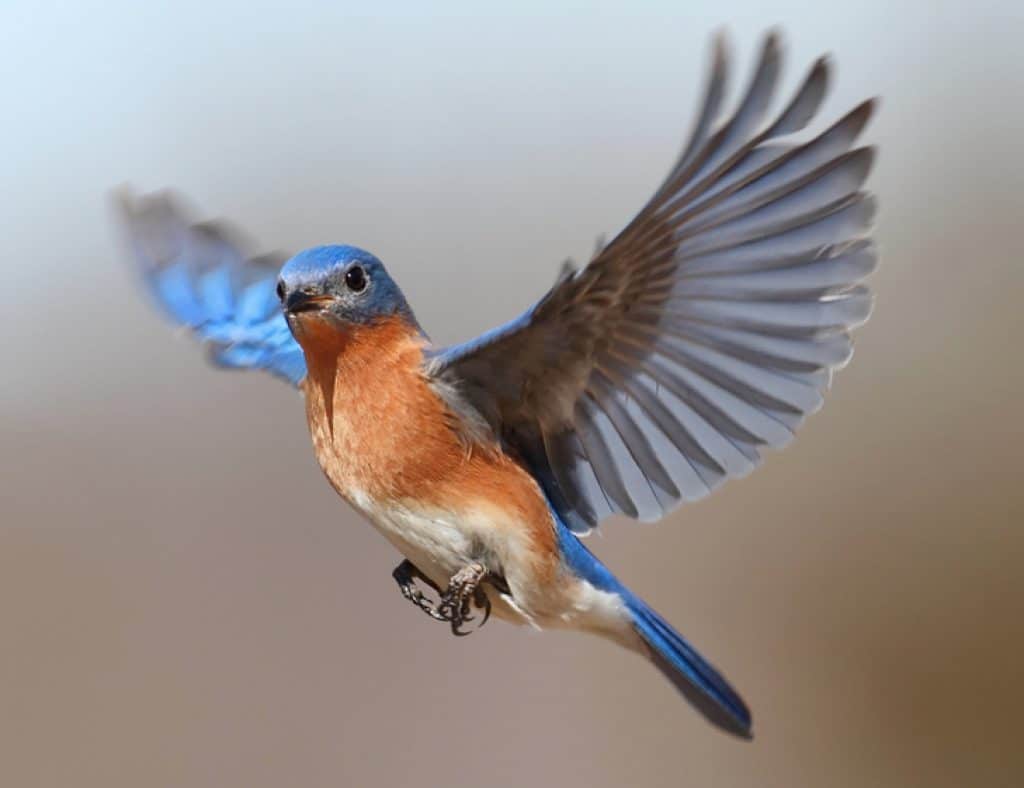
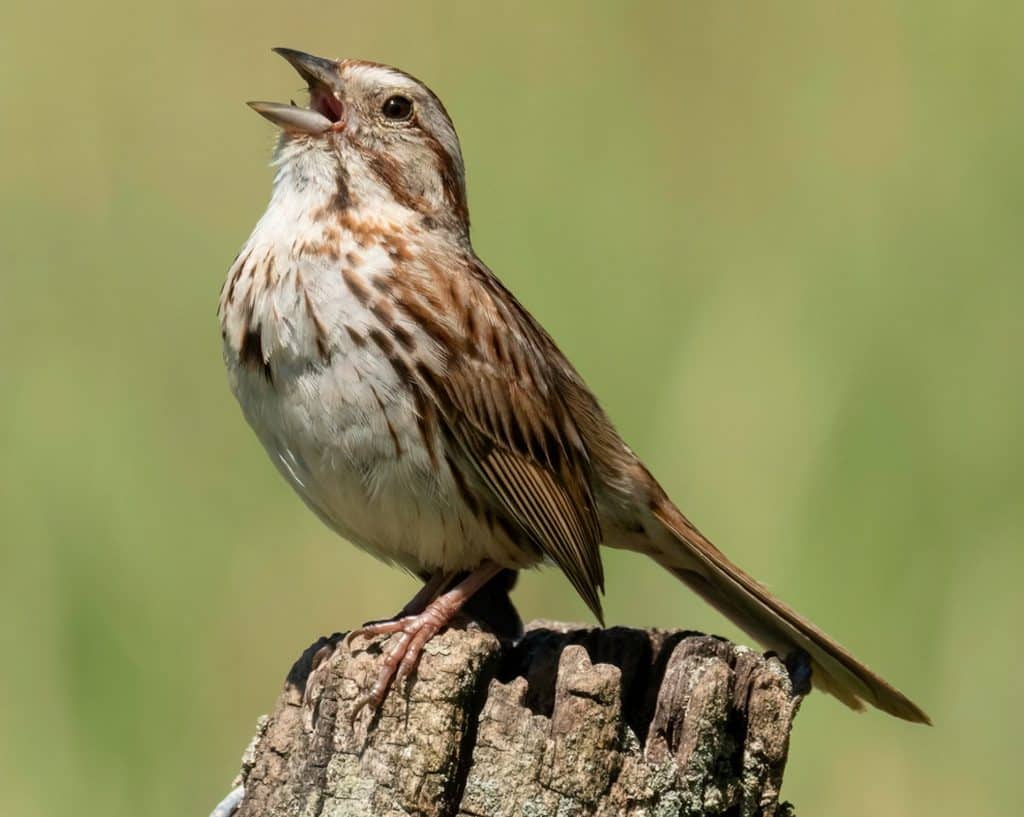
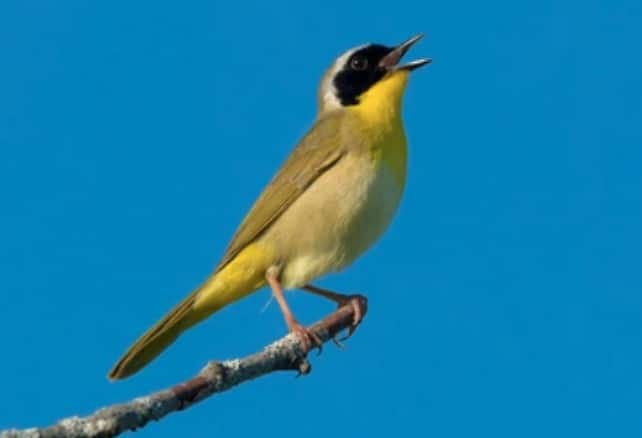
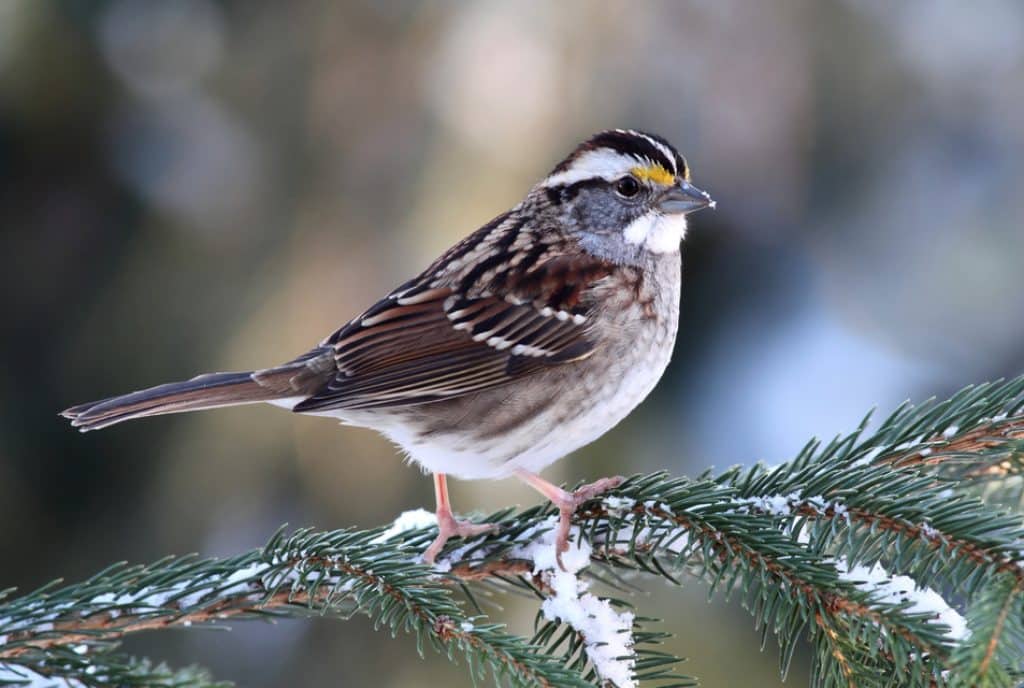
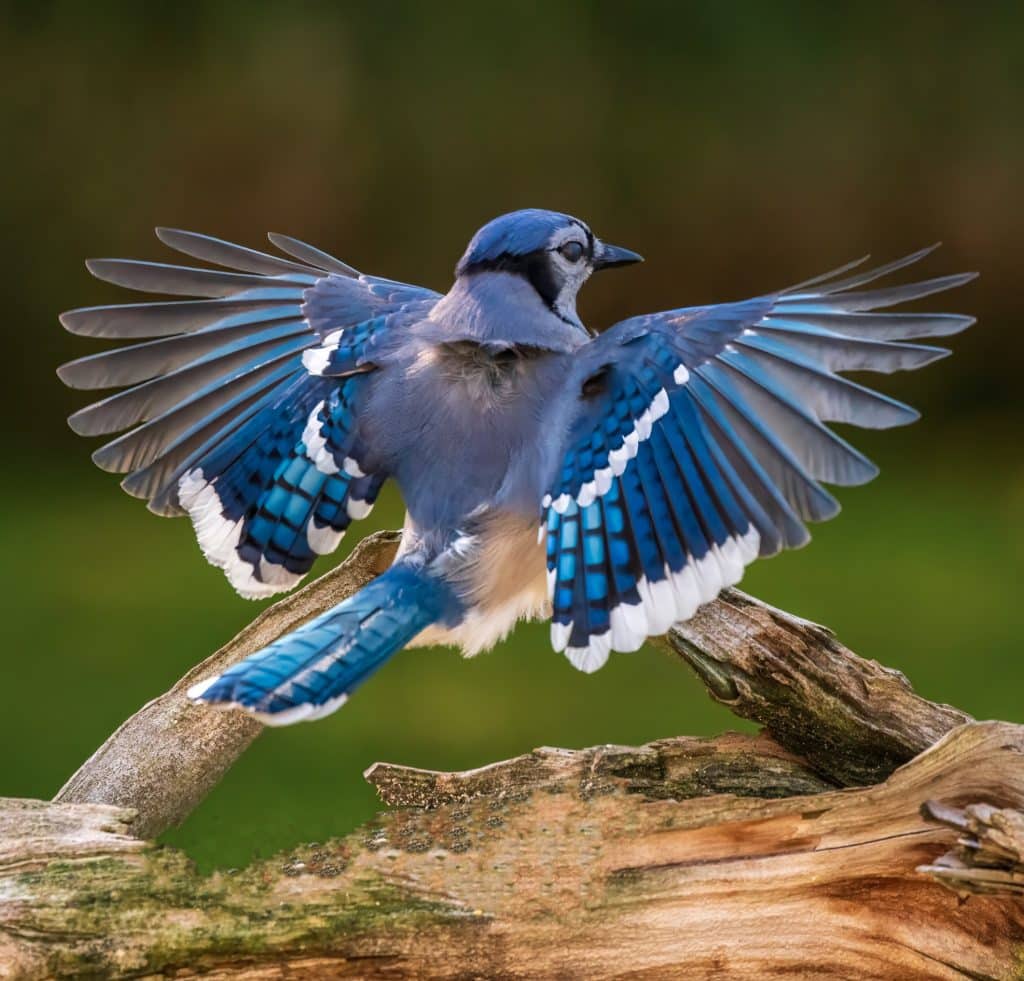
| Bird Species & Scientific Name | Migrates | Physical Description | Preferred Habitat |
|---|---|---|---|
| American Robin (Turdus migratorius) | Yes | Gray-brown with a bright orange underbelly and dark head. | Lawns, gardens, wooded areas |
| Northern Cardinal (Cardinalis cardinalis) | No | Males are bright red with a black face mask; females are pale brown with reddish tinges. | Woodlands, gardens, shrublands |
| Black-capped Chickadee (Poecile atricapillus) | Partially | Small, with a black cap and bib, white cheeks, gray back and wings, and fluffy body. | Deciduous and mixed forests |
| Blue Jay (Cyanocitta cristata) | Partially | Bright blue on top and white to gray below, with a distinctive blue crest on the head. | Forest edges, woodlands, residential areas |
| American Goldfinch (Spinus tristis) | Yes | Summer: males are vibrant yellow with a black cap; winter: duller brownish. | Open fields, gardens, areas with thistles |
| Eastern Bluebird (Sialia sialis) | Yes | Males: bright blue back and rusty throat and chest; females: paler blue with grayish belly. | Open woodlands, fields, roadside |
| Song Sparrow (Melospiza melodia) | Partially | Streaked brown above, white below with dark streaks, and a distinctive central breast spot. | Marshes, fields, edges of water |
| Red-winged Blackbird (Agelaius phoeniceus) | Yes | Males: black with red and yellow shoulder patches; females: brown and heavily streaked. | Wetlands, marshes, agricultural areas |
| Common Yellowthroat (Geothlypis trichas) | Yes | Males: olive back, black face mask, and bright yellow throat; females: duller, without mask. | Marshes, wetlands, grassy areas |
| White-throated Sparrow (Zonotrichia albicollis) | Yes | Striking white throat, with a white or tan-striped head, brown back, and gray breast. | Forests, woodland edges, thickets |
1. American Robin
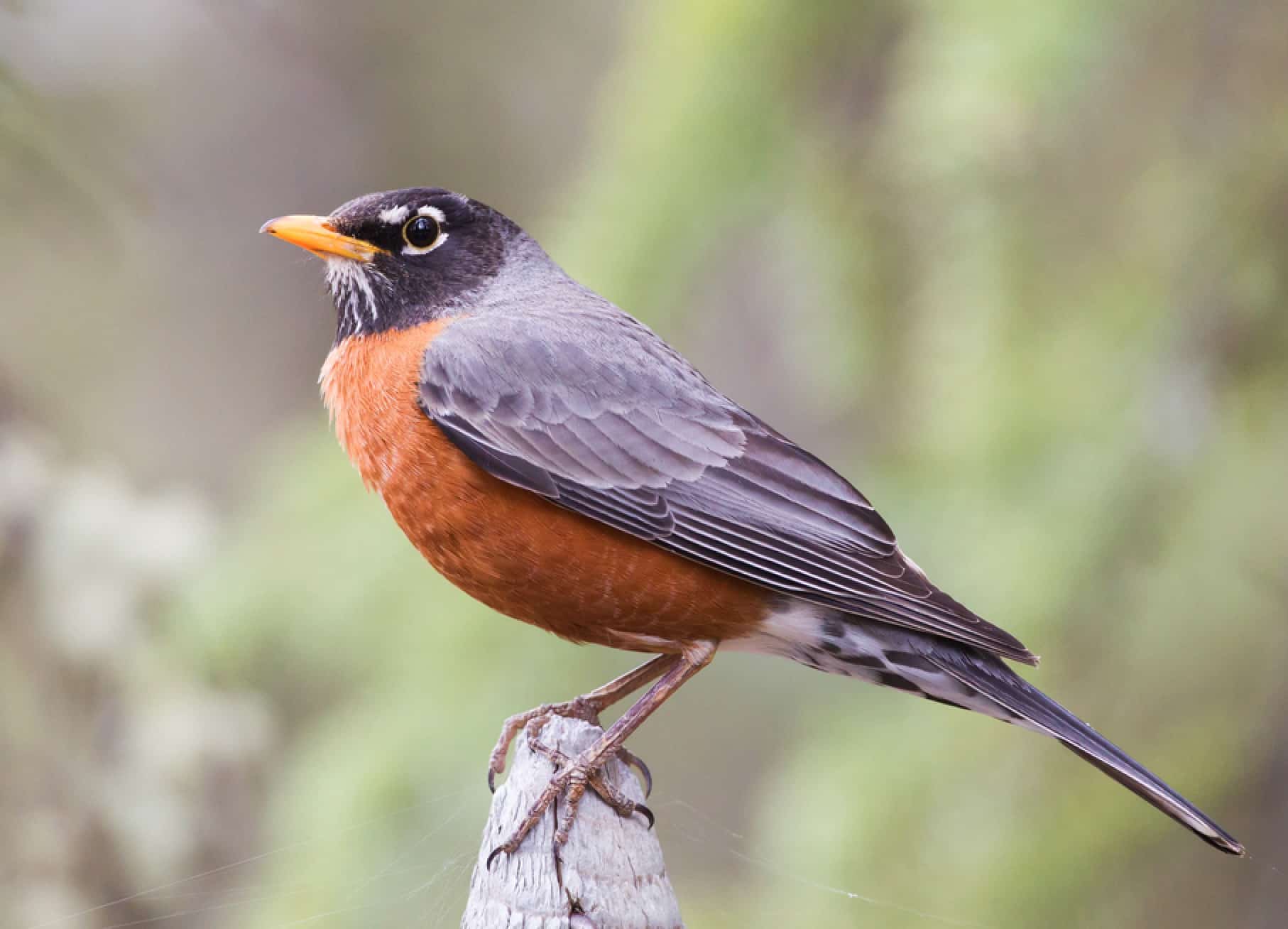
The American Robin (Turdus migratorius) is one of the most familiar and beloved songbirds in Michigan, heralding the arrival of spring with its presence and melodious song. Known for its bright orange belly and cheerful tune, the American Robin is a common sight in backyards, parks, and forests across the state. Let’s explore the characteristics of this popular songbird:
Identification
- Size and Shape: American Robins are medium-sized songbirds with a round body, long legs, and a fairly long tail. They have a distinctive silhouette with a large, round eye and a straight, pointed bill.
- Color Pattern: They are easily identifiable by their bright orange or red belly, gray back and wings, and white throat with dark streaks. Males and females look similar, though males tend to have more vibrant coloring.
Behavior
- Feeding Habits: American Robins are ground feeders that primarily eat worms, insects, and other invertebrates. They are also fond of fruits and berries, often seen feasting on them in gardens and wooded areas.
- Vocalizations: The robin’s song is a series of clear, melodious phrases, each consisting of a few notes, repeated several times. Their calls include a sharp, alarm-like “chirp” that is recognizable to many.
- Migration and Winter Behavior: While some American Robins migrate, many remain in Michigan throughout the winter, forming large flocks and shifting their diet more towards fruit and berries.
Habitat
- Versatile Dwellers: American Robins adapt well to a wide range of habitats, including forests, fields, gardens, and urban areas. Their flexibility allows them to thrive across Michigan, from rural landscapes to suburban backyards.
- Nesting: They build their nests in trees or shrubs, using grass, twigs, and mud. Robins often nest near human habitation, making their breeding habits and chick rearing a familiar sight to many residents.
Conservation Status
- Abundant and Widespread: The American Robin is one of the most common and widespread songbirds in North America. Their population is stable, benefiting from their ability to live in a variety of habitats, including those altered by humans.
Tips for Watching
- Attracting Robins: To attract American Robins to your yard, provide natural food sources like berry-producing bushes or a bird bath for them to drink and bathe, as they are particularly attracted to water.
- Observation Opportunities: Early morning is the best time to hear their beautiful song, as robins are among the first birds to sing at dawn. Look for them hopping along the ground, searching for worms after a rain.
- Citizen Science: Participating in bird counts and other citizen science projects can be a great way to learn more about American Robins and contribute to their conservation.
The American Robin’s familiar presence and song make it a cherished part of Michigan’s natural landscape, symbolizing the changing seasons and the enduring connection between people and nature. Whether in bustling cities or quiet forests, the American Robin continues to delight and inspire bird watchers and nature lovers throughout the state.
2. Northern Cardinal
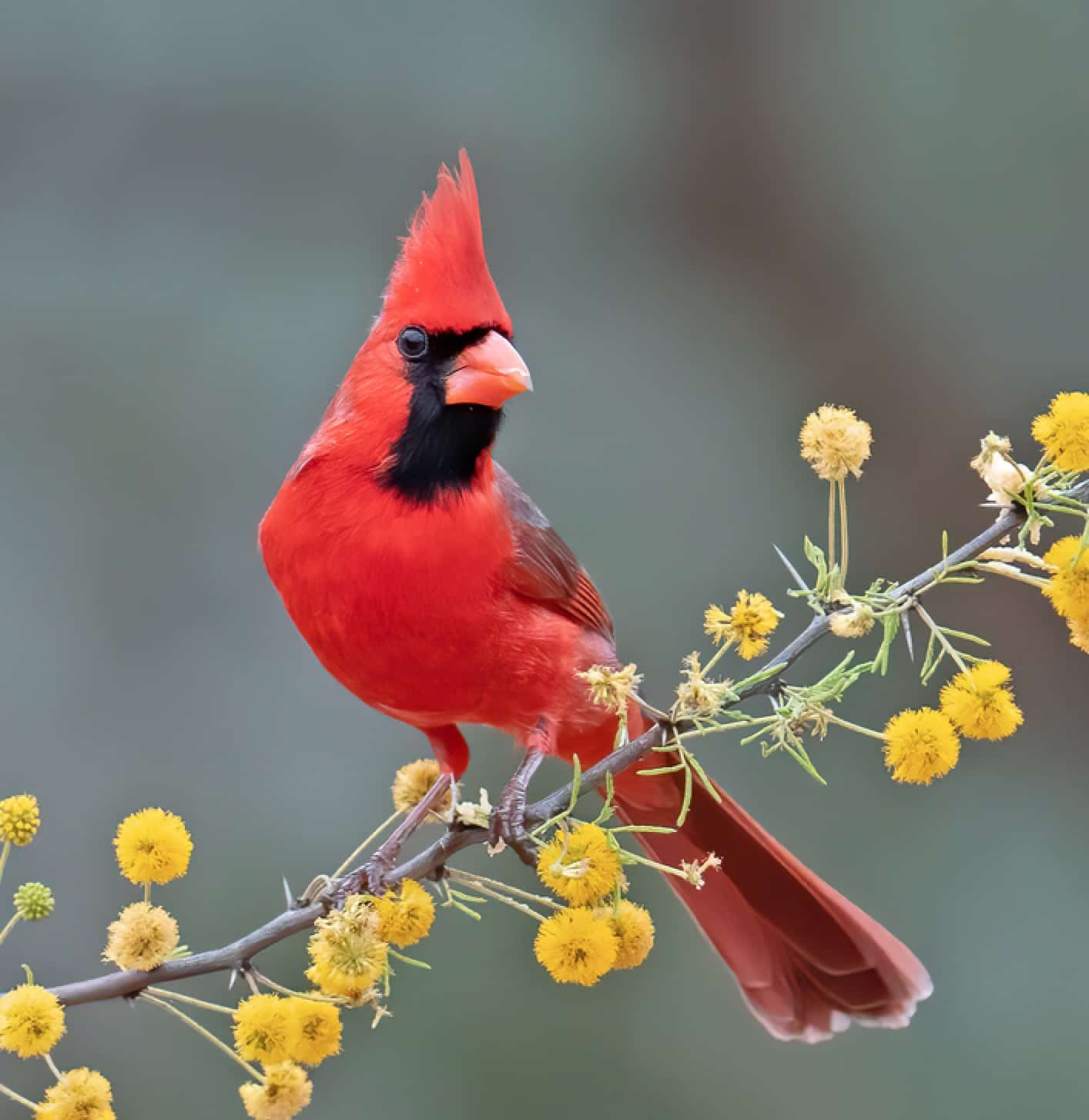
The Northern Cardinal (Cardinalis cardinalis) is one of the most iconic and beloved songbirds found in Michigan, celebrated for its brilliant red plumage and melodious song. This striking bird is a favorite among bird watchers and a vibrant presence throughout the year, even in the snowy winter landscape of Michigan. Let’s delve into the characteristics of the Northern Cardinal:
Identification
- Size and Shape: Northern Cardinals are medium-sized songbirds with a distinctive body shape, featuring a large head, a long tail, and a prominent crest. They have a robust, conical beak that is adapted for seed eating.
- Color Pattern: Males are famous for their vivid red plumage and black mask around the bill, while females are primarily pale brown with warm reddish tinges in the wings, tail, and crest. Both sexes have a distinctive orange beak.
Behavior
- Feeding Habits: Cardinals are mostly seed eaters but also consume fruits and insects. They are frequent visitors to bird feeders, where they prefer sunflower seeds, safflower seeds, and cracked corn.
- Vocalizations: The Northern Cardinal has a variety of songs and calls, with males known for their clear, melodious whistles that vary in pitch and sequence. Females also sing, which is less common among songbirds, often to communicate with their mates.
- Territorial Nature: Cardinals are known for their territorial behavior, especially during breeding season. Males often vigorously defend their territory against other males and have been known to attack their reflection in windows and mirrors.
Habitat
- Adaptable Dwellers: In Michigan, Northern Cardinals can be found in a variety of habitats, including woodlands, garden areas, wetlands, and residential areas. Their adaptability to both natural and human-modified landscapes has helped them thrive.
- Nesting: Cardinals build their nests in dense thickets or low bushes, using twigs, bark strips, and grasses. They prefer nesting sites that offer good cover to protect against predators.
Conservation Status
- Stable and Expanding: The Northern Cardinal population is stable and has been expanding northward over the past century, partly due to the availability of food from bird feeders and the increase in suburban landscapes that provide suitable habitat.
Tips for Watching
- Attracting Cardinals: To attract Northern Cardinals to your yard, provide dense shrubbery for nesting and cover, along with bird feeders filled with their preferred seeds.
- Observation Tips: Cardinals are often more visible during the early morning and late afternoon when they are most active in feeding. Look for them in pairs or alone, as they are not typically flocking birds.
- Photography: Their striking coloration makes cardinals excellent subjects for photography, especially against the snowy backdrop of a Michigan winter.
The Northern Cardinal’s brilliant red plumage and enchanting song make it a standout among Michigan’s songbirds, bringing color and music to the state’s gardens and wild areas throughout the year.
3. Black-capped Chickadee
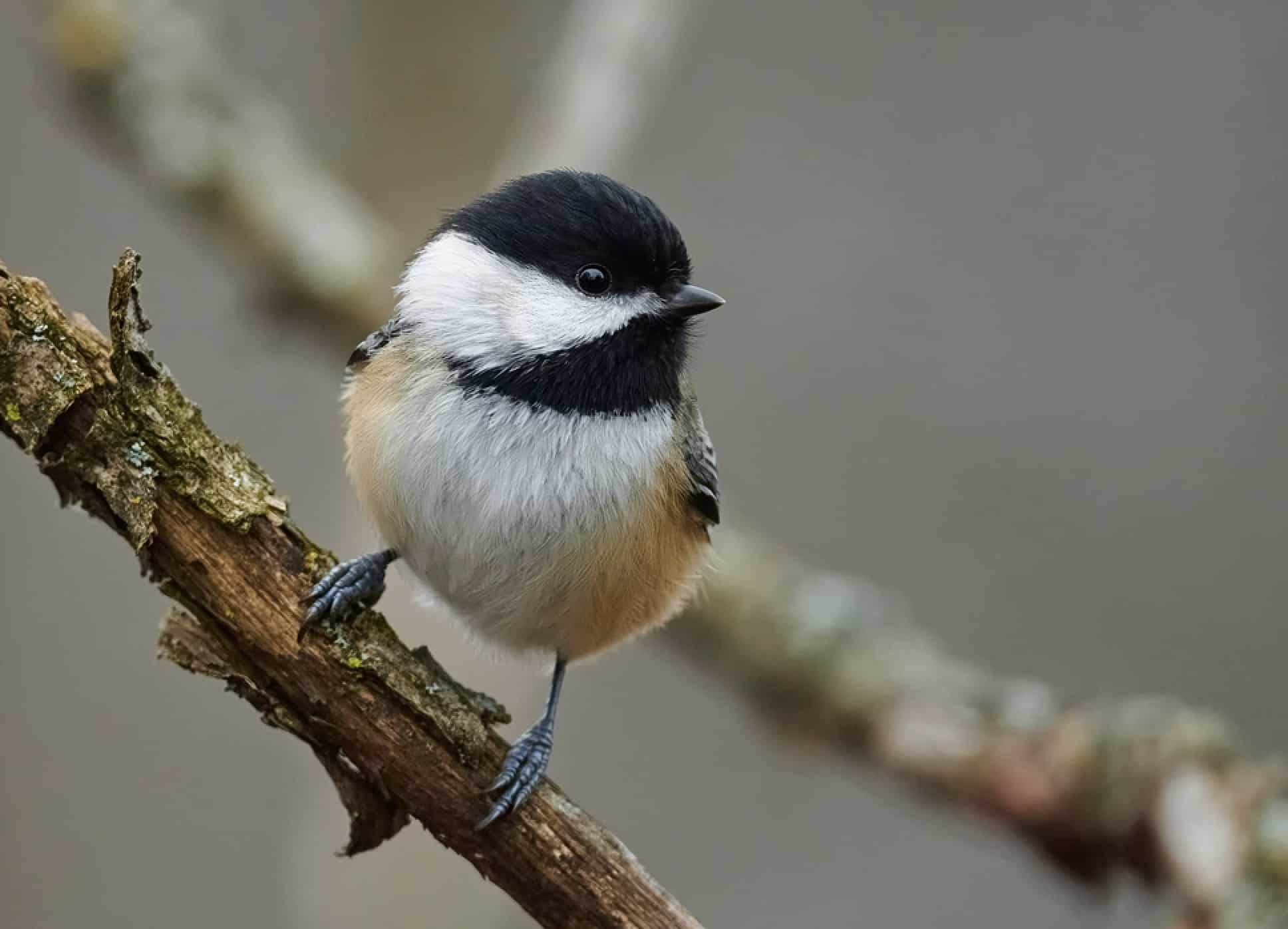
The Black-capped Chickadee (Poecile atricapillus) is a charming and resilient songbird that brings life to the forests and backyards of Michigan throughout the year. Known for their curious nature and distinctive “chick-a-dee-dee-dee” call, these small birds are a delight to observe for bird enthusiasts and casual watchers alike. Let’s explore the features and habits of the Black-capped Chickadee:
Identification
- Size and Shape: Black-capped Chickadees are tiny birds with a large head, short neck, and a tiny body. Their bill is short, stout, and perfect for their diet of seeds and insects.
- Color Pattern: They exhibit a distinctive black cap and bib with white cheeks, a soft gray back, wings, and tail, and a fluffy white underbody. This stark contrast makes them easily identifiable among the foliage.
Behavior
- Feeding Habits: Chickadees are active foragers, often hanging upside down to pick at seeds or insects from the underside of branches. They’re known for caching food to eat at a later time, especially during the colder months.
- Vocalizations: Their iconic “chick-a-dee-dee-dee” call, from which they get their name, varies in intensity and length depending on the threat level. They also have a sweet, high-pitched song that adds to the soundscape of Michigan’s woodlands.
- Curiosity Towards Humans: Black-capped Chickadees are remarkably fearless and curious about humans, often approaching closely, making them favorites among bird feeders.
Habitat
- Woodland Dwellers: In Michigan, they thrive in both deciduous and mixed forests, as well as in suburban and urban areas with ample tree cover. Their adaptability to different habitats makes them common across the state.
- Nesting: They nest in the cavities of trees, often those excavated by woodpeckers, or in nest boxes provided by enthusiasts. Their nests are made of moss, feathers, and other soft materials.
Conservation Status
- Stable Population: The Black-capped Chickadee is not currently at risk, with a stable and healthy population across its range. This is due in part to its adaptability to various environments and the availability of food sources.
Tips for Watching
- Attracting Chickadees: They are easily attracted to feeders with sunflower seeds, peanut butter, and suet. Placing feeders in or near wooded areas can increase your chances of seeing them.
- Observation Tips: Due to their curious nature, chickadees can be observed closely if you move slowly and quietly. They are particularly active in the morning and late afternoon.
- Enjoy Their Presence: The presence of Black-capped Chickadees can be a joy in the colder months, as they remain active and visible when many other birds have migrated south for the winter.
The Black-capped Chickadee’s cheerful presence and playful antics make it a beloved visitor to feeders and a delightful sight in the wild, embodying the spirited heart of Michigan’s birdlife.
4. Blue Jay
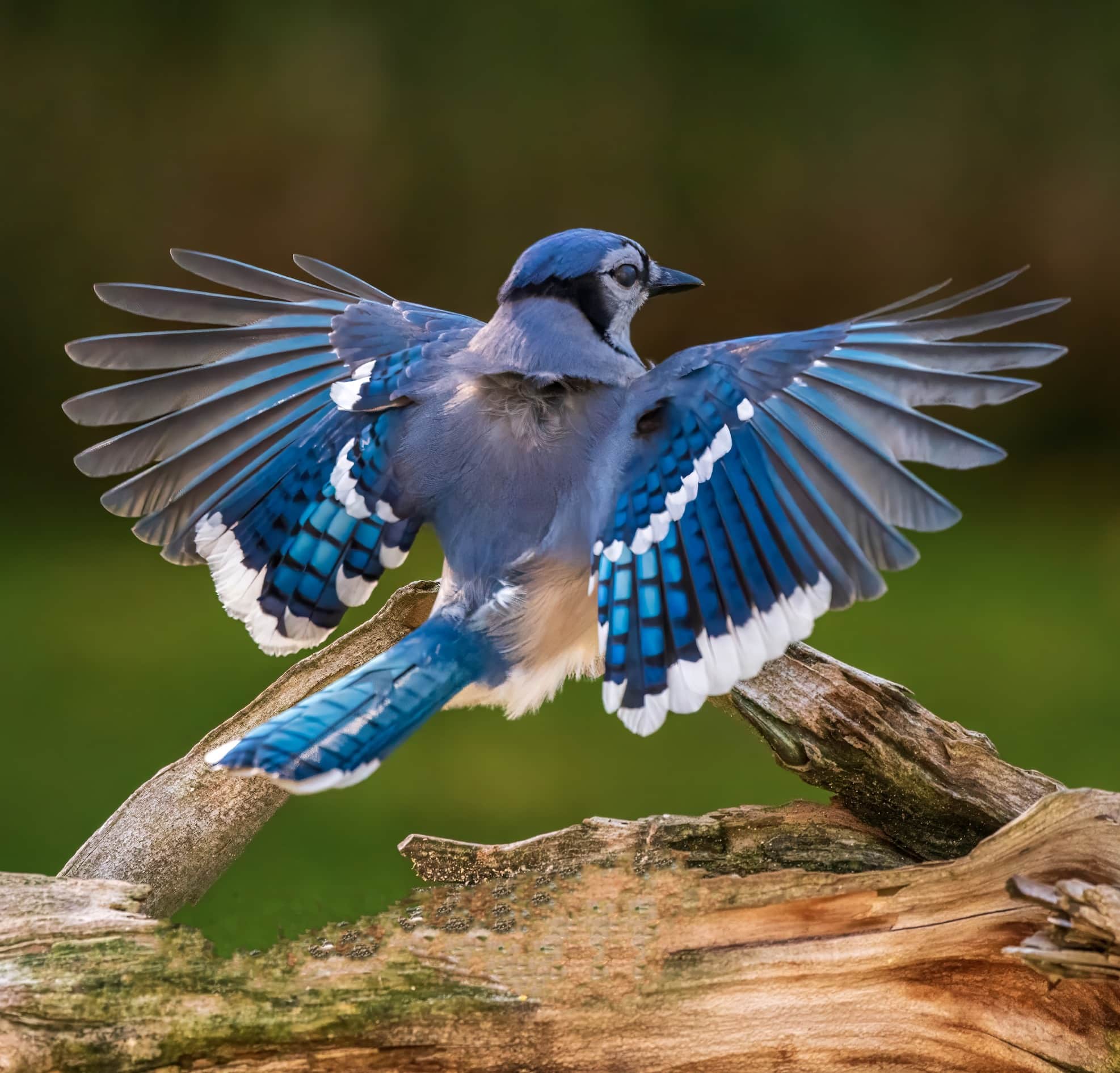
The Blue Jay (Cyanocitta cristata) is a vibrant and intelligent songbird that adds splashes of color and character to the forests, parks, and backyards of Michigan. Recognized for their striking blue plumage and loud calls, Blue Jays are both admired and notorious for their bold behavior. Let’s explore the fascinating world of the Blue Jay:
Identification
- Size and Shape: Blue Jays are large songbirds with a robust body, a large head, and a long, rounded tail. They have a prominent crest on their head that can be raised or lowered depending on their mood.
- Color Pattern: Their plumage is primarily bright blue on the back and wings, with white undersides and black markings around the neck and on the wings and tail. The combination of blue, white, and black makes them unmistakable in their natural habitat.
Behavior
- Feeding Habits: Blue Jays are omnivores, eating a diet that includes seeds, nuts (especially acorns), grains, insects, and occasionally small vertebrates and bird eggs. They are known for their habit of caching food for later consumption.
- Vocalizations: They have a wide range of vocalizations, including the familiar “jay! jay!” call. Blue Jays can also mimic the calls of hawks, which may serve to warn other jays of a hawk’s presence or to deceive other species.
- Social Dynamics: Blue Jays are known for their intelligence and complex social structures. They can be aggressive defenders of their nests and territories but also show strong family bonds and cooperative behaviors.
Habitat
- Versatile Habitats: In Michigan, Blue Jays are found in a variety of wooded habitats, from deep forests to mixed woodlands, and they adapt well to urban and suburban settings. Their versatility makes them a common sight across the state.
- Nesting: They build their nests in the branches of trees, using twigs, grass, and sometimes mud. The nests are typically placed at a medium height and can be quite large and well-constructed.
Conservation Status
- Stable and Widespread: The population of the Blue Jay is stable across its range, which covers much of eastern and central North America. Their adaptability to different environments, including human-altered landscapes, has helped maintain their numbers.
Tips for Watching
- Attracting Blue Jays: To attract Blue Jays to your yard, offer a variety of foods, including peanuts, sunflower seeds, and suet. They also enjoy fresh water from birdbaths.
- Observation Tips: Blue Jays are active during the day, with peak activity in the morning. They’re often seen in pairs or small groups, so look for their bright blue coloring among the treetops or at feeders.
- Respect Their Space: While observing, keep a respectful distance, especially during the breeding season, as Blue Jays can be protective of their nest area.
The Blue Jay, with its striking appearance and bold personality, is a captivating addition to the avian community of Michigan. Their presence adds both beauty and drama to the natural landscape, making them a subject of interest and fascination for bird watchers and nature lovers alike.
5. American Goldfinch
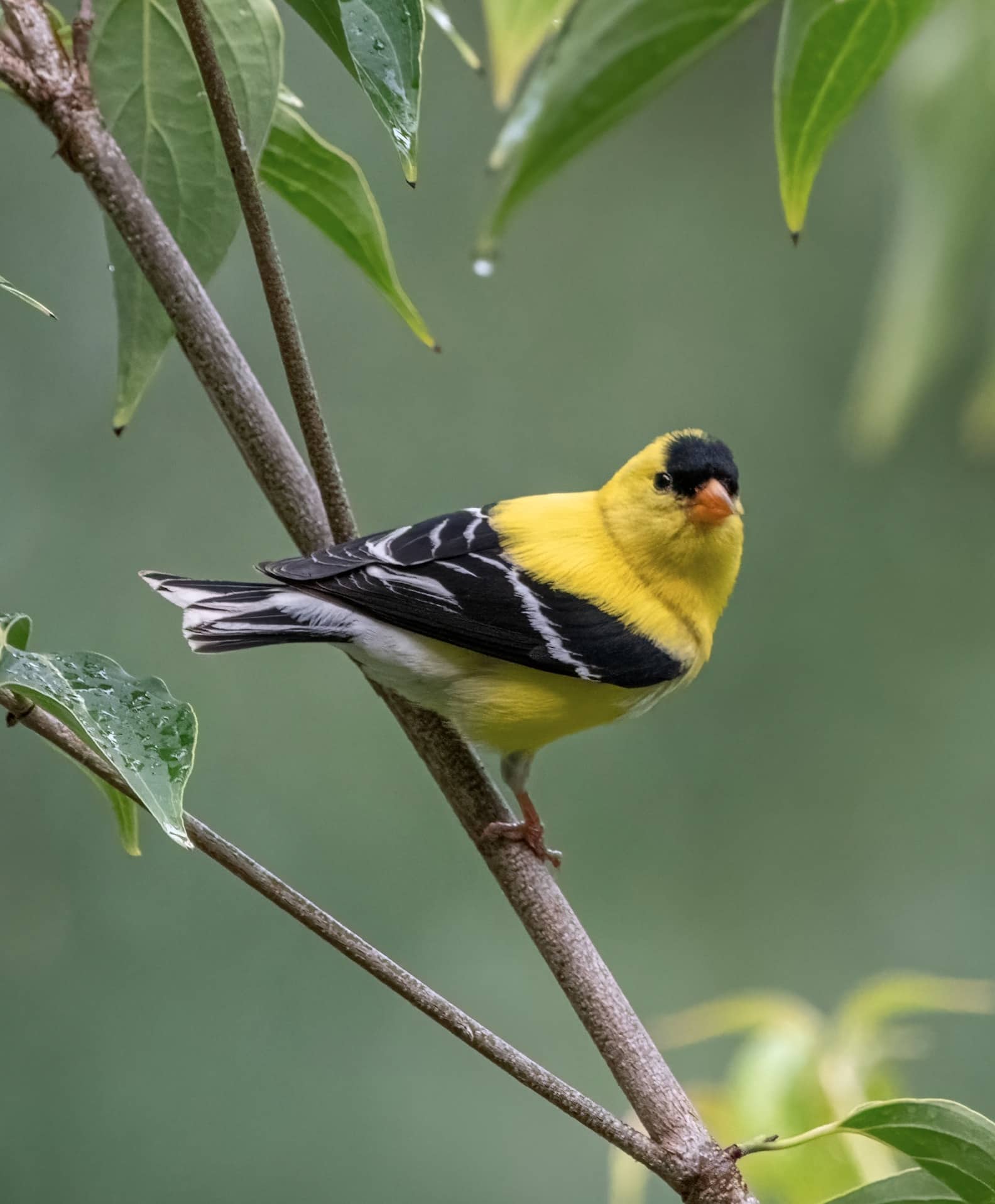
The American Goldfinch (Spinus tristis) is a vibrant splash of yellow in the Michigan landscape, especially noticeable during the summer months. Known for their fluttering flight and cheerful demeanor, these songbirds are a favorite among birdwatchers.
Their adaptability to various environments, including suburban and urban areas, makes them a delightful presence across the state.
Let’s delve into the details of the American Goldfinch:
Identification
- Size and Shape: American Goldfinches are small, delicate songbirds with a short, conical beak adapted for their seed-based diet. They have a small head, long wings, and a short, notched tail.
- Color Pattern: Males in breeding plumage are bright yellow with a black forehead, black wings with white markings, and a white rump. Females and non-breeding males are more subdued, with olive or brownish coloring. Their distinctive flight call and the flash of color in flight make them easily identifiable.
Behavior
- Feeding Habits: Primarily seed eaters, American Goldfinches have a particular fondness for thistle, sunflower, and other small seeds. They are often seen hanging upside down to feed from thistle feeders or plants.
- Vocalizations: Their song is a series of sweet, musical twitters and trills. Their flight call, a po-ta-to-chip sound, is heard commonly during their undulating flight.
- Social Behavior: Goldfinches are highly social outside of the breeding season, often flocking with other finches. Their flocks can be seen flitting about in open fields and meadows or at feeders.
Habitat
- Versatile Dwellers: In Michigan, American Goldfinches are found in weedy fields, gardens, open woodlands, and areas near streams. They adapt well to human environments, often visiting bird feeders in residential areas.
- Nesting: They nest later in the season than many other birds, waiting until June or July when milkweed, thistle, and other plants have produced their fibrous seeds. Their nests are well-crafted, cup-shaped structures built in the branches of trees and shrubs.
Conservation Status
- Stable Population: The American Goldfinch is widespread and common across its range, with stable population numbers. Their adaptability to different habitats and food sources helps maintain their numbers.
Tips for Watching
- Attracting Goldfinches: Planting native thistles and other seed-bearing plants can attract goldfinches. Thistle (nyjer) feeders are particularly effective in drawing them to your yard.
- Observation Tips: Look for American Goldfinches in open, grassy areas or at feeders. Their bright coloring and distinctive flight pattern make them easy to spot.
- Enjoy Their Presence: American Goldfinches are among the most cheerful visitors to any backyard or garden, bringing a sense of joy and vibrancy wherever they go.
The American Goldfinch’s bright plumage and lively song contribute to the rich tapestry of birdlife in Michigan.
6. Eastern Bluebird
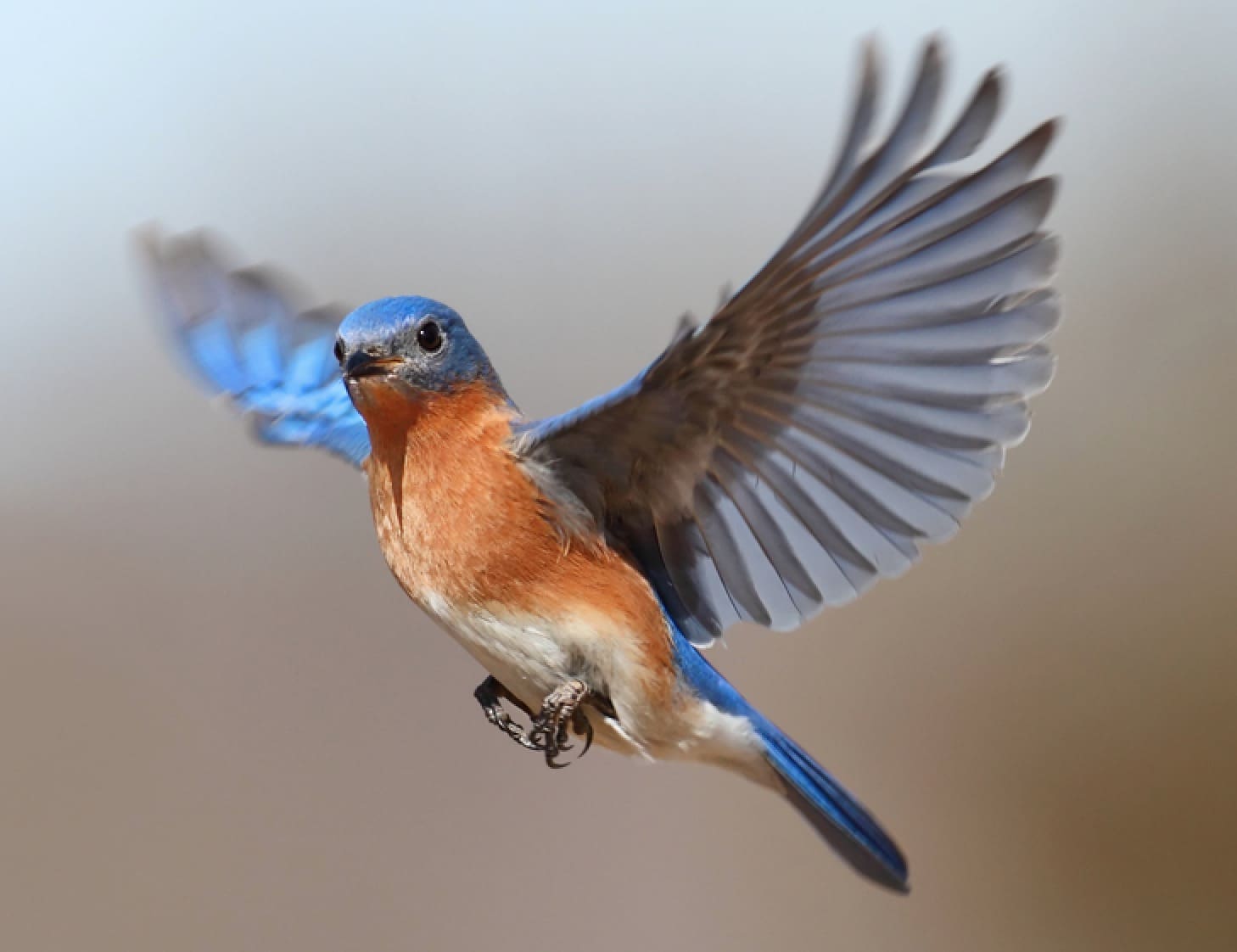
The Eastern Bluebird (Sialia sialis) is a symbol of happiness and a beloved sight in Michigan’s landscapes. With their vibrant colors and sweet songs, these small thrushes bring a touch of beauty to gardens, parks, and rural areas throughout the state.
Eastern Bluebirds are cherished by many for their gentle nature and the splash of color they add to the environment, especially against the backdrop of Michigan’s varied seasons.
Identification
- Size and Shape: Eastern Bluebirds are small to medium-sized songbirds with a round head, plump body, and short, straight bill. They have a slender silhouette with broad wings and a short tail.
- Color Pattern: Males are easily recognizable by their vivid royal blue back and head, with a warm reddish-orange breast and white belly. Females are more subdued, with grayish-blue wings and tail and a lighter orange-brown breast.
Behavior
- Feeding Habits: These birds primarily feed on insects, including beetles, grasshoppers, and caterpillars, as well as fruits and berries. They can often be seen perched quietly on wires or branches, swooping down to catch insects on the ground.
- Vocalizations: Eastern Bluebirds have a soft, melodious song, which consists of a few short notes followed by a warble. Their calls include a soft “chur-wi” or a more urgent “chirp” when alarmed.
- Territorial and Social: During the breeding season, males can become quite territorial, defending their nesting sites vigorously. Outside of breeding, they form small flocks, often including family groups, which can be seen foraging together.
Habitat
- Nesting and Habitat Preferences: In Michigan, Eastern Bluebirds are found in open fields and meadows with scattered trees, edges of woodlands, and along golf courses or orchards. They prefer habitats with open spaces for foraging and perches for lookout points.
- Nesting: They are cavity nesters, using natural tree cavities or abandoned woodpecker holes. The widespread placement of bluebird boxes by enthusiasts has helped increase their nesting sites, supporting population growth in many areas.
Conservation Status
- Conservation Success: The Eastern Bluebird population has rebounded in recent years, thanks to conservation efforts such as the establishment of bluebird trails and the monitoring of nesting boxes, which have provided them with additional safe nesting sites.
Tips for Watching
- Attracting Bluebirds: To attract Eastern Bluebirds to your area, set up nesting boxes in open habitats and provide a water source. Planting native berries and ensuring a pesticide-free environment can also encourage them to visit.
- Observation Tips: Look for Eastern Bluebirds perched on low branches or wires in open areas. Early morning is a great time to hear their songs and see them actively foraging.
- Patience Pays Off: Eastern Bluebirds can be shy, so observing them quietly from a distance with binoculars can be rewarding. Their vibrant colors and peaceful demeanor make them a joy to watch.
7. Song Sparrow
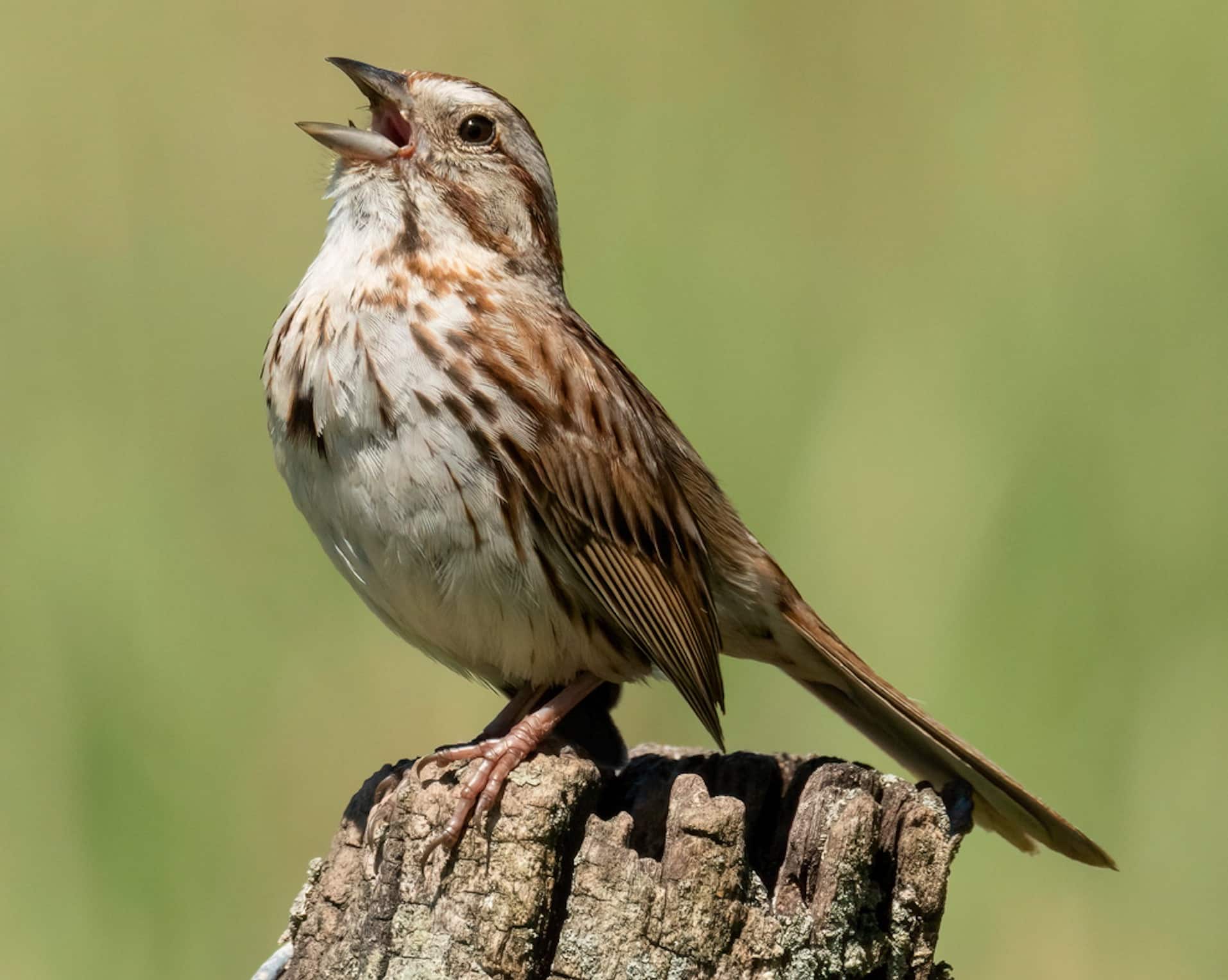
The Song Sparrow (Melospiza melodia) is a ubiquitous presence in Michigan, celebrated for its rich, melodious song that fills the air from dawn till dusk. This adaptable bird can be found in a variety of habitats across the state, making it a familiar sight to many.
With its streaked appearance and persistent singing, the Song Sparrow plays a vital role in the soundscape of Michigan’s outdoor spaces. Let’s delve into the details of this versatile songbird:
Identification
- Size and Shape: Song Sparrows are medium-sized sparrows with a round, full body, a rounded head, and a stout, conical beak typical of seed-eating birds. They have a relatively long tail that they often twitch.
- Color Pattern: They are characterized by their streaked brown and gray plumage, with thick streaks converging into a central spot on their chest. While their overall coloration can vary by region, the pattern of streaks and spots is a good identifier.
Behavior
- Feeding Habits: Song Sparrows are ground feeders, primarily eating seeds and insects. They can often be seen foraging in brushy or grassy areas, using their strong beaks to crack open seeds or capture insects.
- Vocalizations: The Song Sparrow is known for its varied and melodious song, which can include up to 20 different notes and is used to declare territory and attract mates. Their song is a delightful mix of trills, whistles, and gurgles, making them one of the most vocal species in Michigan.
- Adaptability: These birds are highly adaptable, thriving in a wide range of habitats from wetlands to garden spaces. This adaptability has helped maintain their population despite changes in landscape and habitat quality.
Habitat
- Versatile Habitats: Song Sparrows are found in open, shrubby, and wet areas across Michigan, including marshes, fields, edges of woods, and residential areas. They are as comfortable in a backyard as they are in wilder settings.
- Nesting: They nest close to the ground in dense shrubs or grass, constructing nests out of grass, leaves, and twigs. The female lays and incubates a clutch of eggs, which are typically speckled and blend well with the natural environment.
Conservation Status
- Stable Population: The Song Sparrow is common and widespread across its range, with stable population numbers. Its ability to adapt to various environments has helped it thrive in areas where other species have struggled.
Tips for Watching
- Attracting Song Sparrows: To attract Song Sparrows to your yard, maintain a natural, brushy landscape and provide a source of water. They are also attracted to feeders that offer small seeds.
- Observation Tips: Listen for their distinctive song, especially in the early morning, to locate these birds. Once you’re familiar with their song, you’ll start noticing them everywhere.
- Patience and Observation: While Song Sparrows are common, getting a close look requires patience. They can be shy, preferring the safety of thick vegetation, but with time, you can enjoy their lively songs and observe their feeding behavior.
The Song Sparrow’s presence enriches the natural chorus of Michigan, offering a soundtrack that defines the region’s rural and suburban landscapes.
8. Red-winged Blackbird
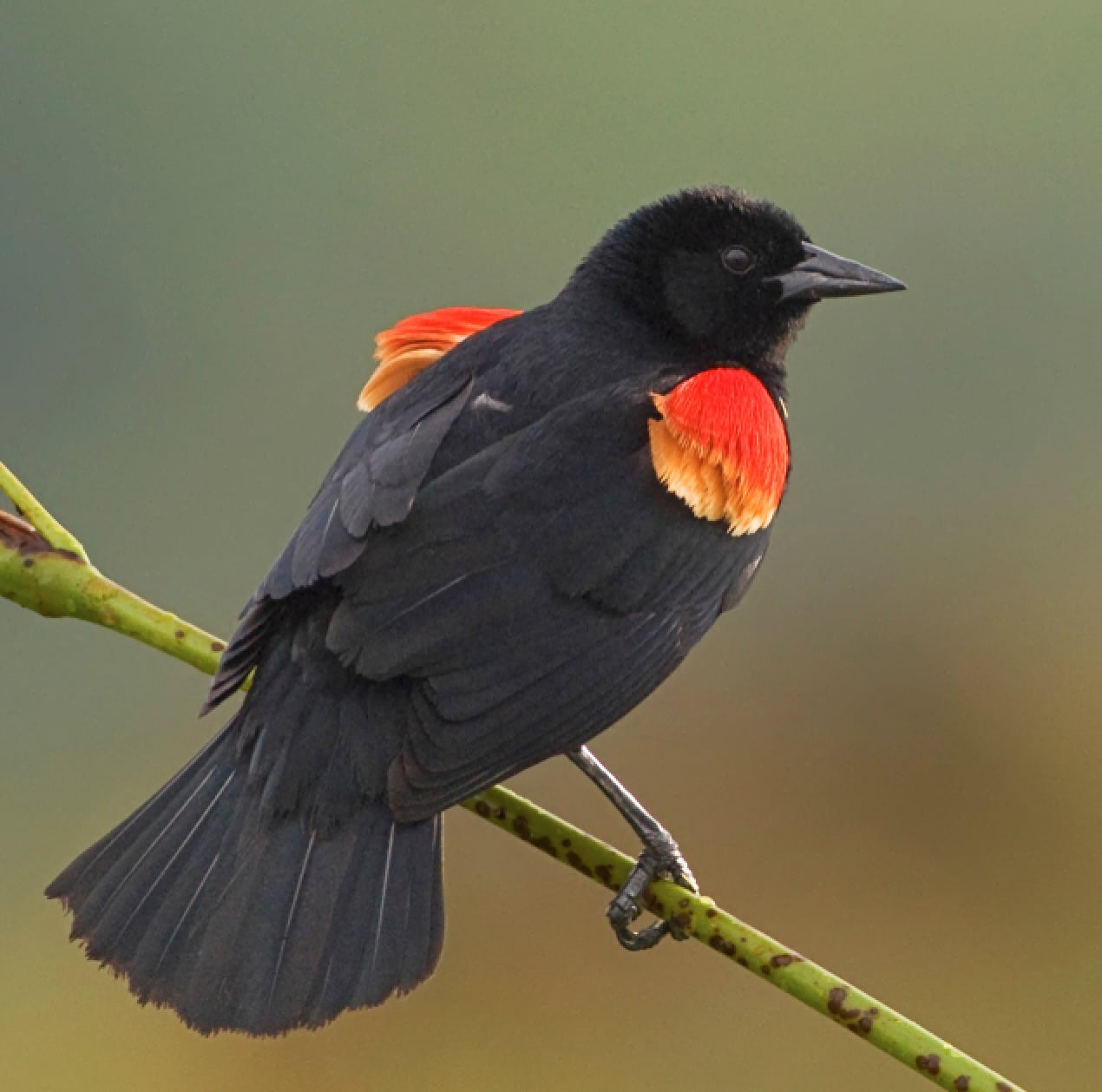
The Red-winged Blackbird (Agelaius phoeniceus) is a striking and familiar sight in Michigan, known for its bold coloration and distinctive, melodious calls.
These birds are a harbinger of spring, returning to Michigan’s wetlands, fields, and marshes in large numbers to breed and fill the air with their songs. Let’s delve into the details of the Red-winged Blackbird:
Identification
- Size and Shape: Red-winged Blackbirds are medium-sized birds with a sleek shape. They have a broad shoulder, sharp, pointed bill, and a tail that is of medium length and often fan-shaped in flight.
- Color Pattern: The males are unmistakable with their glossy black plumage and vibrant red and yellow shoulder patches (epaulets), which they display prominently when singing or defending their territory. Females are more subdued, with streaky brown, sparrow-like coloring, allowing them to blend into their surroundings.
Behavior
- Feeding Habits: These birds are omnivores, feeding on a mix of seeds, grains, insects, and plant material. They often forage on the ground or in vegetation, and can be seen flocking to feeders in large numbers, especially in the winter.
- Vocalizations: The males’ song is a distinctive, liquid “konk-la-ree!” which can be heard throughout their habitat. Their calls serve not only to attract mates but also to declare ownership of their territory.
- Territorial and Social: Red-winged Blackbirds are highly territorial during the breeding season, with males often overseeing multiple females within their territory. Outside of breeding season, they form large, mixed-species flocks that can number in the thousands.
Habitat
- Wetland Dwellers: In Michigan, Red-winged Blackbirds are commonly found in wetlands, marshes, and along the edges of lakes and rivers. They also inhabit agricultural fields and grasslands, where they can find ample food and nesting sites.
- Nesting: Females build their nests in dense wetland vegetation, weaving together reeds and grasses to create a sturdy platform anchored to plants above the water or ground.
Conservation Status
- Widespread and Abundant: The Red-winged Blackbird is one of the most abundant and broadly distributed bird species across North America. While their populations are considered stable, they face threats from habitat loss and degradation, particularly in wetland areas.
Tips for Watching
- Attracting Red-winged Blackbirds: While they are often found in natural wetland settings, these birds can be attracted to backyard feeders with mixed seeds and grains.
- Observation Tips: Look for males perched conspicuously on reeds, fence posts, or utility lines, especially in wetland areas, where they display their shoulder patches and sing. Females are more challenging to spot, as their coloring provides camouflage among the reeds and grasses.
- Enjoy Their Presence: The return of Red-winged Blackbirds is a sign that spring has arrived in Michigan. Their vibrant colors and songs add to the richness of Michigan’s ecosystems and the overall biodiversity of the area.
9. Common Yellowthroat

The Common Yellowthroat (Geothlypis trichas) is a small, charismatic warbler that adds a touch of mystery and color to the wetlands, marshes, and brushy areas of Michigan. Known for its distinctive “witchety-witchety-witchety” song, this masked bandit of the bird world is a joy to discover for birdwatchers.
Despite its vibrant appearance, the Common Yellowthroat can be somewhat elusive, blending into the underbrush with surprising effectiveness. Let’s explore the captivating world of the Common Yellowthroat:
Identification
- Size and Shape: Common Yellowthroats are small, skulking warblers with a chunky body, short tail, and a round head. Their bill is thin and pointed, ideal for picking insects from foliage.
- Color Pattern: Males are most recognizable by their bright yellow underparts and olive back, with a striking black mask across the eyes set against a white head. Females lack the male’s mask and are more uniformly olive-brown with yellowish underparts, making them more challenging to spot.
Behavior
- Feeding Habits: These warblers primarily feed on insects and spiders. They forage actively in low vegetation, often near the ground or in dense shrubbery, darting and flitting about in search of their next meal.
- Vocalizations: The male’s song is a loud and cheerful “witchety-witchety-witchety,” which they sing from hidden perches within thickets or reeds. This song is a key indicator of their presence, as they are often heard before they are seen.
- Territorial and Breeding Behavior: During the breeding season, males become quite territorial, defending their patches of wetlands or thickets vigorously from rivals while trying to attract females with their incessant singing.
Habitat
- Wetland and Brushy Area Residents: In Michigan, Common Yellowthroats are found in a wide range of habitats with dense, low vegetation, including wetlands, marshes, along riverbanks, and in overgrown fields. They are well adapted to both pristine and human-altered landscapes, as long as thick cover is available.
- Nesting: Their nests are cup-shaped and placed low in dense vegetation, woven with grasses and lined with finer materials. This placement keeps their nests hidden from predators.
Conservation Status
- Stable but Watchful: While Common Yellowthroats are widespread and common across their range, they, like many other songbirds, face threats from habitat loss and degradation. Conservation efforts aimed at preserving wetlands and other critical habitats are vital for their continued wellbeing.
Tips for Watching
- Finding Common Yellowthroats: To spot these elusive warblers, listen for their song and watch for movement in low bushes and thickets, especially near water. Early morning is often the best time for birdwatching, as many birds are more active and vocal.
- Patience is Key: Given their skulking nature, observing Common Yellowthroats may require patience. Standing still and waiting for them to emerge from cover can be rewarding.
- Contribute to Conservation: Participating in bird surveys and supporting habitat conservation efforts can help ensure that Common Yellowthroats and other songbirds continue to thrive in Michigan and beyond.
The Common Yellowthroat’s vibrant song and secretive behavior make it a fascinating subject for birdwatchers in Michigan, offering glimpses into the complex dynamics of the state’s wetlands and brushy habitats.
10. White-throated Sparrow
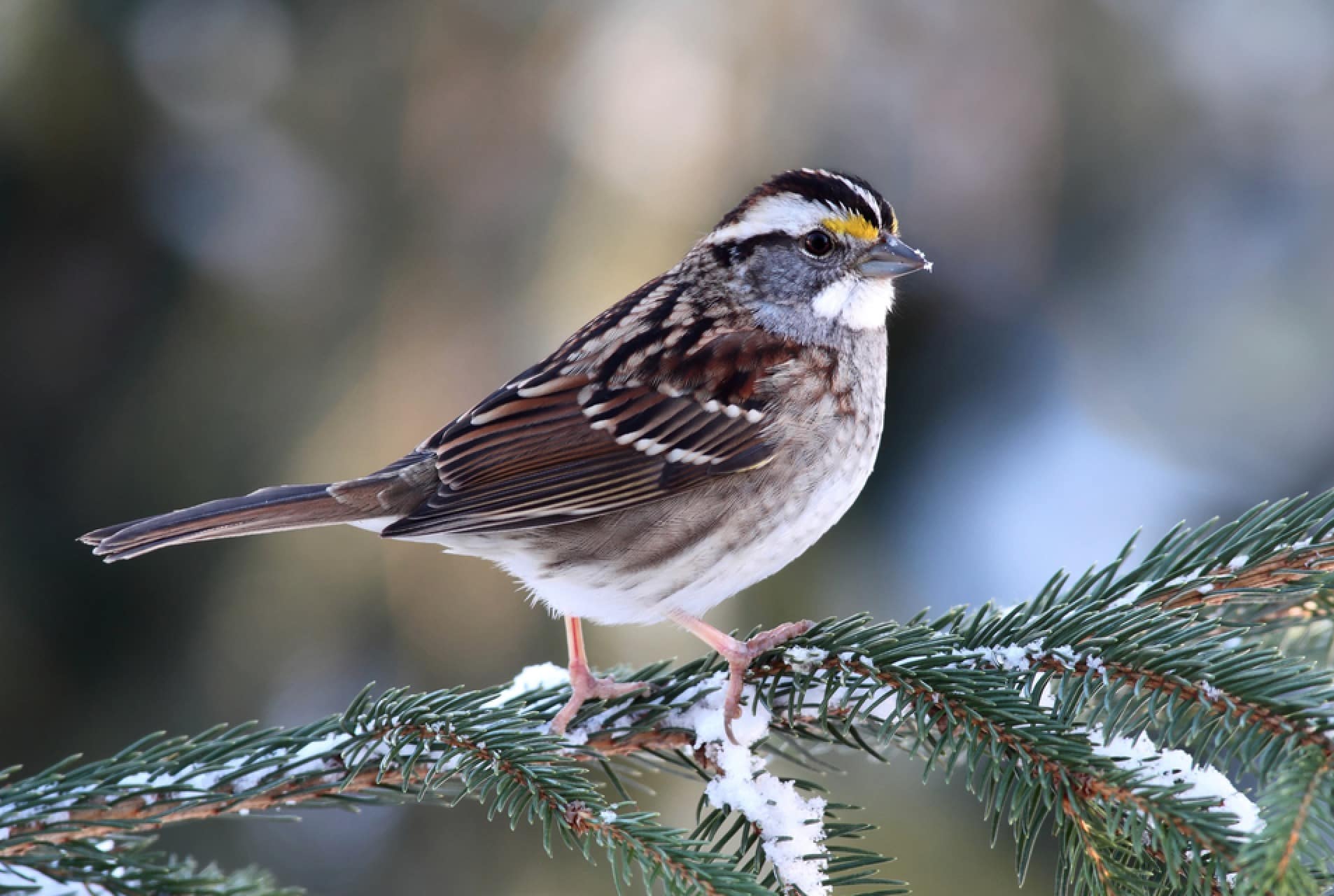
The White-throated Sparrow (Zonotrichia albicollis) is a distinctive and much-loved visitor to Michigan, especially noted for its beautiful, haunting song that sounds like it’s whistling the phrase “Oh-sweet-canada-canada-canada.”
These birds are a common sight during the migration seasons and in the winter, adding charm to the colder months with their presence and melodies. Let’s delve into the details of the White-throated Sparrow:
Identification
- Size and Shape: White-throated Sparrows are medium-sized sparrows with a fairly robust build, a round head, and a long tail. They have a distinctive appearance, marked by their stout bill suitable for seed eating.
- Color Pattern: They feature a striking white throat patch, bright yellow lores (the regions between the eyes and bill on the side of a bird’s head), and a contrasting black-and-white striped head. Their breast is gray, and their back is brown with streaks, which helps them blend into their surroundings when foraging on the ground.
Behavior
- Feeding Habits: These sparrows primarily feed on the ground, foraging for seeds, fruits, and insects. In the colder months, they often visit feeders, where they can be seen eating sunflower seeds, millet, and other seed mixes.
- Vocalizations: The song of the White-throated Sparrow is one of the most recognizable and evocative sounds of the Michigan landscape, particularly in spring and fall. They also have a sharp, tinny call note used for communication within flocks and with their mates.
- Social Behavior: Outside of the breeding season, White-throated Sparrows can be found in large flocks, mixing with other sparrows and songbirds. They exhibit a mix of aggressive and cooperative behaviors, especially around feeding areas.
Habitat
- Migration and Wintering Grounds: While they breed in the boreal forests of Canada, White-throated Sparrows migrate through Michigan and often spend the winter here. They are found in a variety of wooded habitats, including forest edges, thickets, and suburban areas with ample cover.
- Nesting: During the breeding season, they nest on or near the ground, constructing their nests out of grasses, twigs, and leaves, and lining them with finer materials for insulation and comfort.
Conservation Status
- Generally Stable: The White-throated Sparrow population is considered stable, though they face threats from habitat loss and window collisions during migration. Conservation efforts focused on protecting migratory pathways and wintering habitats are important for their continued well-being.
Tips for Watching
- Attracting White-throated Sparrows: To attract these sparrows to your backyard during their migration or winter stay in Michigan, provide ground feeders or scatter seeds on the ground. A water source and dense shrubbery can also encourage them to visit and stay longer.
- Observation Tips: Listen for their distinctive song, which can help locate them in areas where they might be feeding or resting. Early morning and late afternoon are prime times for birdwatching.
- Appreciate Their Journey: Remembering that these sparrows are long-distance migrants can enhance the appreciation of their presence and the importance of providing habitats that support them during their travels.
The White-throated Sparrow enriches Michigan’s winters and migration seasons with its melodic song and striking appearance, reminding us of the cyclic and interconnected nature of the natural world.
Still here? As of it’s writing, this is the longest article on this site. Thanks for reading!